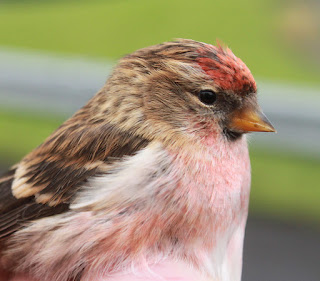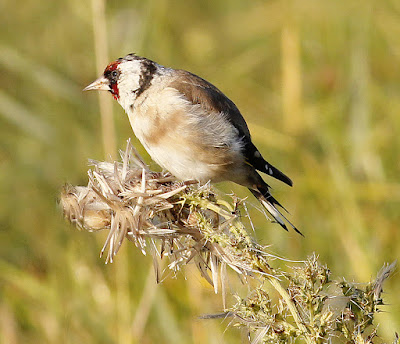Sunday 27th December - a dry, sunny morning. There haven’t been too many Fieldfares in evidence in recent weeks. By mid-winter our hedgerows are more or less devoid of haw berries, a favoured food of the northern thrush. By January Fieldfares feed almost exclusively on the ground and use hedgerows only as a hiding place/escape route when disturbed from searching the ground.
Out on Pilling Moss I came across a huge flock of 1400 Fieldfares, a necessary approximation of highly mobile birds spread across at least two or three fields. This count is many times the numbers of Fieldfares reported locally in recent weeks. I can only think that the floods of recent days across parts of both Lancashire and Yorkshire had displaced lots of Fieldfares and pushed them west to where our fields are very wet but do not resemble the huge floods of TV news reports.
Fieldfare
While so many Fieldfares proved difficult to count the sight was one to enjoy, with lots more to see by sticking around the immediate area for a while. Nearby fields and hedgerows plus a particularly good-looking flooded stubble held 150+ Starlings, 100+ Linnets, 80 Skylark, 70+ Chaffinch, 12+ Meadow Pipit, 3 Reed Bunting, 5 Pied Wagtail, 1 Grey Wagtail, 2 Mistle Thrush and 2 Yellowhammer. By now Starlings can be sporting their spring plumage - a male below.
Starling
Close by were 3 Kestrels - a pair and a single bird. Kestrels mate for life so it is not unusual to see pairs in mid-winter, especially since the shortest day is past and more daylight beckons. Buzzards were about, keeping their usual low and distant profile, leading me to think that at least three were in the immediate area.
Kestrel
At Cockerham the Linnet flock of late was in the expected place with about 80 birds and a single Stonechat sitting up briefly before doing the usual disappearing trick. Extra today was a single Grey Wagtail and 2 Reed Buntings frequenting the roadside ditch.
Grey Wagtail
The sunny morning and roadside flood of Fluke Hall was an attraction to both holiday bird watchers and dog walkers; too many of each for my liking. After noting 40+ Skylarks and a good number of Meadow Pipits I turned around and walked the sea wall and then the woodland where a couple more Skylarks and Tree Sparrows knocking around nest boxes enlivened a fairly birdless route.
It was here that I bumped into a non-birder acquaintance, one who knows his birds and someone in close contact with local shooters. He told me of thousands of Mallards, Teal, Wigeon and Pintail frequenting a huge farmland flood some four or five miles inland. It seems that the sportsmen are kicking their heels in despair that the fields are so deep in water that they are unable to get anywhere close to the wildfowl in order to conduct a mass slaughter.
It’s an ill wind indeed that doesn’t provide even a smidgeon of good news.
Log in soon for more news and views soon from Another Bird Blog.
Linking today to Eileen's Saturday and Stewart's World Bird Wednesday.
Linking today to Eileen's Saturday and Stewart's World Bird Wednesday.



















































































